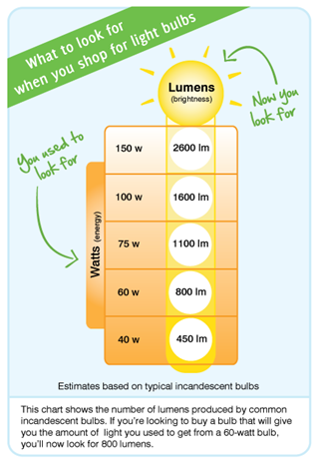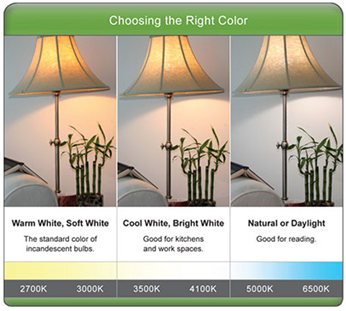by Chris Martin
Congratulations! You’re thinking about buying (maybe!) a new LED1 light bulb and you’re really not sure what you need to get. This short guide will give you the basic ‘need to know’ information so that you are not floundering when you get to the hardware store.
Here are the THREE most important things to know about them:
- Are they going to be bright enough for what I need?
- Are they going to have a nice color and how do I choose the color?
- Are they worth it? (really, $25 for a light bulb that used to cost 25¢ !!)
OK, let’s get started with the BRIGHTNESS question
In the past many of us thought of light bulb brightness in terms of Watts2. Technically, wattage is really a measure of how much electricity the bulb consumes; it was also a reasonable guide to how bright they were. Nowadays, there is a better number that shows brightness and it is called Lumens3. This table shows you the rough equivalence.
So, for example if you like a 60W ‘old’ bulb, then replace it with a ‘new’ bulb rated at 800 Lumens.
Currently, LED bulbs are typically not available in sizes above 800 Lumens. For now, if you need more than about 800 lumens you need multiple LED bulbs, or otherwise, a traditional or CFL bulb.
And that is really all there is to it!
OK, now for the COLOR (or how it makes the room look).
Let’s be honest, the early ‘new’ bulbs were pretty horrible with color: they made a room look really cold and people a bit like aliens! This has changed a lot now, and rooms can look as good as the equivalent light from the old (incandescent) bulbs.
So just like brightness, there is a new scale, Kelvin4 or ‘K’, to show color and this is how it works:
If you want a relaxing, warm, “soft” look (most like the old bulbs), then go for the bulbs with a lower ‘K’ number. So 2700K – 3000K is “warm or soft”. In the middle are the cooler colors, and on the right a more natural ‘daylight’ color that is great for an office or garage environment. You may notice that the prices of the lower K (warmer-looking) bulbs are sometimes MORE expensive than the colder ones.
So that’s it for color!!
OK, now the final question: ARE THEY WORTH IT?
Traditional old bulbs are being phased out by law5. The “replacement” halogen incandescent bulbs, such as 43 Watts instead of 60 Watts for an 800 Lumen bulb, will be more expensive and may have a shorter lifespan.
Let’s face it, in a world where prices seem to come down, how come the price for the new LED bulbs is HIGHER? It really comes down to the TOTAL COST OF OWNERSHIP. The new bulbs are FAR MORE expensive than the old ones, but they last FAR LONGER and use FAR LESS power6, so overall they work out cheaper (and their price IS coming down all the time as the manufacturing costs go down).
Also, because they last longer they are very convenient if you use them in a place where it is hard to change the bulb (for example in a high ceiling). It is not unusual to see an LED bulb with at least a FIVE YEAR warranty – which certainly helps one feel safer about buying such an expensive bulb!
That being said, here is one important thing to look out for: All electrical devices including bulbs do not survive well when turned on and off frequently, after all how often does a bulb “pop” just as you turn it on. At 25¢ no one worries too much if a bulb pops, but at $25 it seems like a crime!
So if the bulb is on for less than 15 minutes at a time (for example in a bathroom or closet), then you likely don’t want an LED bulb just yet.
LEDs are not CFLs
CFLs, the curly bulbs, mostly look the same (see the photo at the top of the post).
LEDs vary widely in appearance. Don’t be perturbed by the colors of the bulbs when unlit!
LED bulbs do not have these notable CFL challenges:
- LEDs have an “instant on”, unlike CFLs that come on slowly
- CFLs have a reputation for not starting when cold such as in an unheated garage during the winter
- CFLs may not work well with a dimmer switch
- CFLs have been cited for environmental concerns as all CFLs contain mercury in small amounts and as a result they present recycling challenges
Good luck at the hardware store!
Footnotes:
1) Acronyms: Light Emitting Diode (LED); Compact Fluorescent Lamps (CFL)
2) Watts: In homage to James Watt engineer of steam engine fame, the Watt is a measure of electrical consumption. Incandescent light bulbs, as invented by Joseph Swan and Thomas Edison, have been traditionally rated in Watts and generally Watts translated into brightness. Watts, by the way, is also an ideal measure of heat, something incandescent bulbs do quite well easily demonstrated by the 100 Watt light bulb in an EasyBake oven, and why electrical space heaters are conveniently rated in Watts!
3) Lumens: Even before LEDs and CFLs, the Watt was failing as an ideal measure of brightness. Easily 15 years ago, manufacturers were introducing “double life” bulbs which although convenient for hard to change locations, ran less brightly while consuming a specific wattage. This introduced Lumen output on the packaging to be required as a better indicator of brightness.
4) Kelvin: Color temperature specified in degrees Kelvin of a black body radiator. Quite a complex topic. For further reading see wikipedia.org/wiki/Color_temperature and
apps1.eere.energy.gov/buildings/publications/pdfs/ssl/led-color-characteristics-factsheet.pdf
5) Energy Independence and Security Act of 2007 requires a 25% increase in efficiency for light bulbs, to be phased in from 2012 through 2014. These newer more efficient incandescent bulbs burn hotter to generate equivalent light with less watts, however with hotter filaments, bulb life is greatly shortened.
6) An 800 lumen LED bulb may use only 9 Watts compared against 60 Watts for a traditional 800 lumen incandescent bulb .
Lighting a 60 Watt bulb 8 hours a day for 30 days consumes 14.4 KiloWatt hours in a month thus costs $2.30 per month @ $0.16/kWh
Lighting a 9 Watt LED bulb 8 hours a day for 30 days consumes 2.1 KiloWatt hours in a month thus costs $0.34 per month @ $0.16/kWh
So, if you light a single 800 lumen LED bulb rather than an incandescent 800 Lumen bulb for a month you save about $2.00.





Leave a Reply